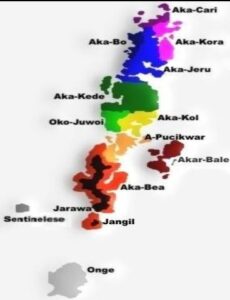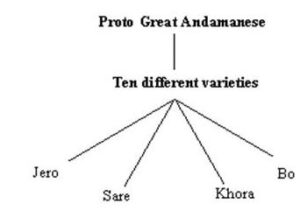“The Jarawa will be decimated, just like us”- expressed by Lichu, the last speaker of Great Andamese
Tribes into despair

Figure 1: Great Andamese languages
Every tribe had its separate language in earlier times and several languages among them become extinct over the years. Now Great Andamese speaks a mixed language which is increasing tension to lose indigenous languages. The threat is not only for today but for the future. Great Andamese are considered the earliest tribes in the world. Reportedly, they are dwelling on the Andaman Islands for more than sixty thousand years (Majumdar, 2021). Unfortunately, they are on the verge of extinction nowadays due to their rapidly reducing population dwindling from approximately five thousand in the 19th century to only 50 today. The Great Andamese were collectively known and included ten distinct tribes. However, due to inter-tribal marriage, the population is sinking and the present generation is called mixed parentage. Primitively the tribes used to lord over large parts of Andaman. But with the dawn of the 21st century, the tribes herded together in Strait Island which is about fifty kilometers far from Port Blair. Well known for their hunting, the Great Andamese now live upon the ration provided by the government. Even the dietary habits have changed and the traditions and culture have lost their way.
The shift of Andamese
Significantly, the Great Andamese tribes have shifted to another language losing their hold on indigenous languages. Aka-Kora, Aka-Jeru, and Aka-Bo are some of the tribal languages that are vanished by 2010 in India due to the lacking majority of speakers. Disappointedly, the last speaker of Aka Cari languages, Lichu took the last hope with her death. Here the pandemic threatened the endangered languages and dissolved the last hope for preserving the languages (Abbi, 2020). The catastrophe is never-ending. However, presently, the Great Andamese use Hindi as a medium of communication. Many more languages of Andaman and Nicobar are going to encounter the same fate in the coming future. On the other side, the Shompen tribe of the Nicobar community are dwelling in relative isolation and their language is again under threat. No one can deny that languages awaken the collective memory, culture, knowledge, and mythology associated with tribal communities as a whole. Due to this, the preservation of these languages is necessary.

Figure 2: Languages in Great Andaman
(Source: VOGA, 2021)
It’s high time to think
Tribal languages are vanishing everywhere in the world and a plethora of factors play a role in it. United Nations declaration is now paying attention to preserving such languages in India by safeguarding the language rights of the tribes. Not only this, the UN general assembly declared 2019 as the International Year of Indigenous languages to ponder over the loss of indigenous languages and the urgency to undertake action for promoting, revitalizing, and preserving the languages (Majumdar, 2021). Presently, the era between 2022-2032 has been declared as an International Decade of the indigenous language within which the United Nations will try every possible measure the preserve and document those languages in India which are to be dissolved in near future. The preservation programs are very much important for the preservation of culture, knowledge, and tradition that may benefit modern science.
References
Abbi, A. (2020, April 20). The Pandemic Also Threatens Endangered Languages. Retrieved from Scientific American: https://blogs.scientificamerican.com/voices/the-pandemic-also-threatens-endangered-languages/
Majumdar, A. (2021, June 5). Disappearing dialects. Retrieved from Millenium post: http://www.millenniumpost.in/sundaypost/inland/disappearing-dialects-442406?infinitescroll=1
VOGA. (2021). Vanishing the voices of Great Andamese. Retrieved from VOGA: http://www.andamanese.net/lang_analysis.html